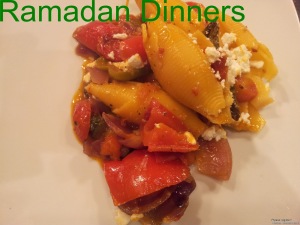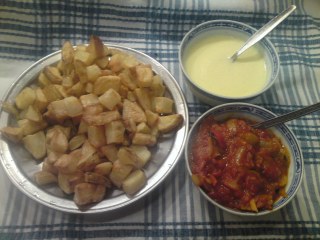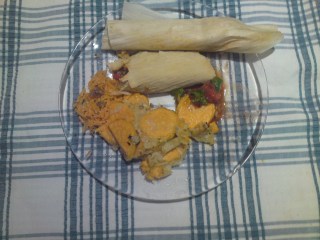Alhamdulilah we have reached the half-way point of Ramadan. On one hand I feel pleased with the achievements I have made and pray inshallah that I am able to continue with them. On the other hand a sense of sadness that this beautiful month’s blessings are set to end. I pray inshallah that our fasts are accepted, that he helps those muslims stuck in refugee camps or are displaced, those that do not have enough food or water, those whose families have been torn from them, that those who are in the process of leaving this world are able to do so easily, that most of all Allah(swt) rains his mercy on us and finally that he guides our non-muslim families to the right path. Ameen.
The funny thing about this iftari was that I really was unable to think that day. I couldn’t decide what to make for dinner. My husband’s contribution was South America which was great but I really didn’t want to go to the shops and yet this meal came together really well.
For our Mexican Ifari this was our menu plan:
Stuffed red chillies
Brazil nut and cheese balls
Empanadas
Guacamole
Meat balls with vegetables
Re-fried dhal
Arroz Rojo
Normally arroz rojo is spicy. I decided not to make mine spicy as everything else was spicy and we also have a spicy v non spicy conflict in our house. So it is always nice to make something which works for both sets of people.
1 tablespoon rapeseed oil
1 clove garlic
1 tablespoon cumin seeds
1 large beef tomato
1 onion
1 cup of basmati rice
Wash and leave the rice to soak for at least 20 minutes.
Use a pan large enough to hold the cooked rice. Slice the onion and allow to brown in the oil, then add the clove of garlic, then add the cumin seeds. Chop the tomato quite finely, add the tomato, it’s juice and seeds in to the pan and allow to cook slightly with the onions.
25 minutes before iftari, drain off the rice and place into the pan with the tomatoes, heat up on a moderate heat to allow the rice to be mixed in with the tomatoes. Then add enough water to cover the rice so that when your finger is on top of the rice the water should reach the first line on your index finger. Bring to boil, then turn down to a low heat and put a lid on the pan. Allow to cook gently. Check the rice at 20 minutes it should be soft and fluffy.
Stuffed Red Chillies
I used long red chillies for this, but any that are large enough to handle would work well. Just try and beware of the heat of the chillies so that you don’t make the stuffing too hot.
Wash and deseed the chillies, cut a slit along the side and take out the white bits and the seeds. You can keep some seeds aside and put them in to the stuffing.
I used the percentage of 50:50 brazil nuts to mature cheddar cheese, I put these in a food processor and then blitzed till they were fine. Finally add in some of the chilli seeds. There is no need to add salt as the cheese is quite salty.
Put the cheese mix into the chillies. Put into a 250 degree oven for 10 – 15 minutes or until the chilies are cooked and the cheese is melting.
Brazil nut and cheese balls
These were literally thrown together as an after-thought and everyone loved them.
I made these using the left over stuffing mix from above, simply by adding freshly chopped coriander, egg and some gluten free flour to the mix until it formed a wet dough. I shaped into balls (making sure to wet my hands so that the dough did not stick to it) and then cooked into the oven for about 15 minutes at 250 degrees.
Meatballs with vegetables
One of the things that I do every year before Ramadan is to make up huge batches of spiced meatballs, cook them and then place then (in a box) in the freezer. I find they are very easy to use in different recipes and are excellent as a fall back for when you have unexpected guests.
If you don’t have spiced meat balls already in your freezer you could make some up fresh simply by mixing minced beef or lamb with onions, garlic, ginger, green chilli, egg and dry spices to taste. Alternatively use less spices and make them milder. Form golf ball sized balls then shallow fry on all sides, then allow to cool before freezing or going on to use them in this recipe.
Ingredients
1 onion finely sliced
1 aubergine finely cubed
1 courgette finely cubed
10 beef meatballs – cooked
2 cloves garlic minced
1 teaspoon cumin seeds
1 teaspoon chipotle powder
1/2 tablespoon coriander seeds
2 tablespoon rapeseed oil
Heat the oil in a pan and add the onion and cook gently until browned, raise the heat and then add the cumin and coriander seeds, aubergine and courgette and garlic. Turn the vegetables in the onions until they are heated then add the chipotle powder and stir through again. Then add enough water to cover the vegetables and then simmer for about 15 minutes or until the vegetables are cooked through and are soft. Add in the meatballs and add in enough water to cover the vegetables and meatballs and allow to simmer gently for about 20 minutes.
Re-fried dhal
Instead of having re-fried beans I opted for making re-fried dhal. I had ready cooked dhal in the freezer which I just defrosted and just fried off in cumin seeds and sliced green chilli. You could literally do this with any cooked lentil or pulse.
















